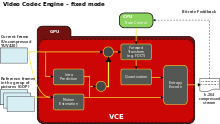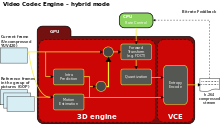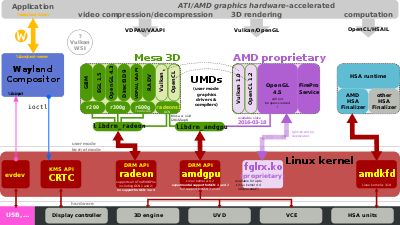Video Coding Engine
Video Coding Engine[1] (VCE, sometimes incorrectly referred to as Video Codec Engine[2]) is AMD's video encoding ASIC implementing the video codec H.264/MPEG-4 AVC. Since 2012 it is integrated into all of their GPUs and APUs.
Video Coding Engine was introduced with the Radeon HD 7900 on 22 December 2011.[3][4][5] VCE occupies a considerable amount of the die surface and is not to be confused with AMD's Unified Video Decoder (UVD).
Overview


The handling of video data involves computation of data compression algorithms and possibly of video processing algorithms. As the template Compression methods shows, lossy video compression algorithms involve the steps: Motion estimation (ME), Discrete cosine transform (DCT), and entropy encoding (EC).
AMD Video Codec Engine (VCE) is a full hardware implementation of the video codec H.264/MPEG-4 AVC. The ASIC is capable of delivering 1080p at 60 frames/sec. Because its entropy encoding block is also separately accessible Video Codec Engine can be operated in two modes: full-fixed mode and hybrid mode.[2][6]
By employing AMD APP SDK, available for Linux and Microsoft Windows, developers can create hybrid encoders that pair custom motion estimation, inverse discrete cosine transform and motion compensation with the hardware entropy encoding to achieve faster than real-time encoding. In hybrid mode, only the entropy encoding block of the VCE unit is used, while the remaining computation is offloaded to the 3D engine (GCN) of the GPU, so the computing scales with the number of available compute units (CUs).
VCE 1.0
As of April 2014, there are two versions of VCE.[1] Version 1.0 supports H.264 YUV420 (I & P frames), H.264 SVC Temporal Encode VCE, and Display Encode Mode (DEM).
It can be found on
- Piledriver-based
- Trinity APUs (Ax - 5xxx, e.g. A10-5800K)
- Richland APUs (Ax - 6xxx, e.g. A10-6800K)
- GPUs of the Southern-Island-Generation (GCN 1.0: CAYMAN, ARUBA (Trinity/Richland), CAPE VERDE, PITCAIRN, TAHITI, OLAND). These are
- Radeon HD7700 series (HD 7790 (VCE 2.0))
- Radeon HD7800 series
- Radeon HD7900 series
- Radeon HD8570 to 8990 (HD 8770 (VCE 2.0))
- Radeon R5 240 / R7 240 / R7 250 / R7 250E / R7 250X / R7 265 / R9 270 / R9 270X / R9 280 / R9 280X
- Radeon R5 330 / R5 340 / R7 340 / R7 350 / R7 370 / R9 370 / R9 370X
- Mobile Radeon HD 77x0M to HD 7970M
- Mobile Radeon HD 8000-Series
- Mobile Radeon Rx M2xx Series (R9 M280X: VCE 2.0, R9 M295X: VCE 3.0)
- Mobile Radeon R5 M330 to Radeon R9 M380 and Radeon R9 M390
- FirePro Cards with 1st Generation GCN (GCN 1.0)
VCE 2.0
Compared to the first version, VCE 2.0 adds H.264 YUV444 (I-Frames), B-frames for H.264 YUV420, and improvements to the DEM (Display Encode Mode), which results in a better encoding quality.
It can be found on
- Steamroller-based
- Kaveri APUs (Ax - 7xxx, e.g. A10-7850K)
- Godavari APUs (Ax - 7xxx e.g. A10-7890K)
- Jaguar-based
- Kabini APUs (e.g. Athlon 5350, Sempron 2650)
- Temash APUs (e.g. A6-1450, A4-1200)
- Puma-based
- Beema and Mullins
- GPUs of the Sea-Islands-Generation as well Bonaire or Hawaii GPUs (2nd generation Graphics Core Next GCN 1.1), such as
- Radeon HD 7790 / HD 8770
- Radeon R7 260 / R7 260X / R9 290 / R9 290X / R9 295X2
- Radeon R7 360 / R9 360 / R9 390 / R9 390X
- Mobile Radeon R9 M280X
- Mobile Radeon R9 M385 / R9 M385X
- Mobile Radeon R9 M470 / R9 M470X
- FirePro-Cards with second Generation GCN 1.1
VCE 3.0
Video Coding Engine 3.0 (VCE 3.0) technology features a new high-quality video scaling.,[7] and will also support for High Efficiency Video Coding (HEVC, H.265,[8] but As of May 2015, there are no announcements about VP9 video codec support.[9][10][11]
It, together with UVD 6.0, can be found on 3rd generation of Graphics Core Next (GCN 1.2) with "Tonga", "Fiji", "Iceland", and "Carrizo" (VCE 3.1) based graphics controller hardware, which is now used AMD Radeon Rx 300 Series (Pirate Islands GPU family) and VCE 3.4 by actual AMD Radeon Rx 400 Series (Arctic Islands GPU family).
- Tonga: Radeon R9 285, Radeon R9 380, Radeon R9 380X / Mobile Radeon R9 M390X / R9 M395 / R9 M395X / Radeon R9 M485X /
- Tonga XT: FirePro W7100 / S7100X / S7150 / S7150 X2 /
- Fiji: Radeon R9 Fury / R9 Fury X / R9 Nano / Radeon Pro Duo / FirePro S9300 / W7170M
- Polaris: RX 460 / 470 / 480
Feature overview
| Brand | Llano | Trinity | Richland | Kaveri | Carrizo | Bristol Ridge | Raven Ridge | Desna, Ontario, Zacate | Kabini, Temash | Beema, Mullins | Carrizo-L | Stoney Ridge | |
|---|---|---|---|---|---|---|---|---|---|---|---|---|---|
| Platform | Desktop, Mobile | Mobile | Desktop, Mobile | Ultra-mobile | |||||||||
| Released | Aug 2011 | Oct 2012 | Jun 2013 | Jan 2014 | Jun 2015 | Jun 2016 | May 2017 | Jan 2011 | May 2013 | Q2 2014 | May 2015 | June 2016 | |
| Fab. (nm) | GlobalFoundries 32 SOI | 28 | 14 | TSMC 40 | 28 | ||||||||
| Die size (mm2) | 228 | 246 | 245 | 244.62 | 250.04 | TBA | 75 (+ 28 FCH) | ~107 | TBA | 125 | |||
| Socket | FM1, FS1 | FM2, FS1+, FP2 | FM2+, FP3 | FM2+, FP4 | FP4 | AM4, FP5 | FT1 | AM1, FT3 | FT3b | FP4 | FP4 | ||
| CPU architecture | AMD 10h | Piledriver | Steamroller | Excavator | Zen | Bobcat | Jaguar | Puma | Puma+[12] | Excavator | |||
| Memory support | DDR3-1866 DDR3-1600 DDR3-1333 | DDR3-2133 DDR3-1866 DDR3-1600 DDR3-1333 | DDR4-2400 DDR4-2133 DDR4-1866 DDR4-1600 | DDR3L-1333 DDR3L-1066 | DDR3L-1866 DDR3L-1600 DDR3L-1333 DDR3L-1066 | DDR3L-1866 DDR3L-1600 DDR3L-1333 | Up to DDR4-2133 | ||||||
| 3D engine[lower-alpha 1] | TeraScale (VLIW5) | TeraScale (VLIW4) | GCN 2nd Gen (Mantle, HSA) | GCN 3rd Gen (Mantle, HSA) | GCN 4th Gen[13] (Mantle, HSA) | TeraScale (VLIW5) | GCN 2nd Gen | GCN 3rd Gen[14] | |||||
| Up to 400:20:8 | Up to 384:24:6 | Up to 512:32:8 | Up to 768:48:12 | 80:8:4 | 128:8:4 | Up to 192:?:? | |||||||
| IOMMUv1 | IOMMUv2 | IOMMUv1[15] | TBA | TBA | |||||||||
| Unified Video Decoder | UVD 3 | UVD 4.2 | UVD 6 | TBA | UVD 3 | UVD 4 | UVD 4.2 | UVD 6 | UVD 6.3 | ||||
| Video Coding Engine | N/A | VCE 1.0 | VCE 2.0 | VCE 3.1 | TBA | N/A | VCE 2.0 | VCE 3.1 | |||||
| GPU power saving | PowerPlay | PowerTune | N/A | PowerTune[16] | |||||||||
| Max. displays[lower-alpha 2] | 2–3 | 2–4 | 2–4 | 3 | 4 | TBA | 2 | TBA | TBA | ||||
| TrueAudio | N/A | ✔[18] | N/A[15] | TBA | |||||||||
| FreeSync | N/A | ✔ | N/A | TBA | |||||||||
/drm/radeon[19][20] |
✔ | N/A | ✔ | N/A | |||||||||
/drm/amd/amdgpu[21] |
N/A | ✔[22] | ✔ | N/A | ✔[22] | ✔ | |||||||
- ↑ Unified shaders : texture mapping units : render output units
- ↑ To feed more than two displays, the additional panels must have native DisplayPort support.[17] Alternatively active DisplayPort-to-DVI/HDMI/VGA adapters can be employed.
Operating system support
The VCE SIP core needs to be supported by the device driver. The device driver provides one or multiple interfaces, like e.g. OpenMAX IL. One of this interfaces is then used by end-user software, like e.g. GStreamer or HandBrake, to access the VCE hardware and make use of it.
AMD's proprietary device driver AMD Catalyst is available for multiple operating systems and support for VCE has been added to it. Additionally, a free device driver is available. This driver also supports the VCE hardware.
Linux

- Initial VCE support has been added on 4 February 2014 by Christian König of AMD to the free radeon driver.[23]
- Gallium3D state tracker for OpenMAX was added 24 October 2013 to Mesa 3D.[24]
- The free and open-source Radeon driver has been adapted to using OpenMAX with the GStreamer OpenMAX (gst-omx) support for exposing the VCE video encode engine.[25]
- AMD employee Leo Liu implemented h264 level support into the Mesa 3D state tracker.[26]
Windows
The software "MediaShow Espresso Video Transcoding" seems to utilize VCE and UVD to the fullest extent possible.[27]
XSplit Broadcaster supports VCE from version 1.3.[28]
Open Broadcaster Software (OBS Studio) supports VCE for recording and streaming. The original Open Broadcaster Software (OBS) requires a fork build in order to enable VCE.[29]
Remotr (PC to Phone / Tablet Streaming Software) supports VCE for streaming, resulting in increased overall FPS during gameplay on the handheld device.[30]
See also
- Intel Quick Sync Video, Intel's equivalent SIP core
- Nvidia NVENC, Nvidia's equivalent SIP core
References
- 1 2 http://developer.amd.com/community/blog/2014/02/19/introducing-video-coding-engine-vce/
- 1 2 "Video & Movies: The Video Codec Engine, UVD3, & Steady Video 2.0". AnandTech.
- ↑ http://www.amd.com/Documents/UVD3_whitepaper.pdf
- ↑ "AnandTech Portal | AMD Radeon HD 7970 Review: 28nm And Graphics Core Next, Together As One". Anandtech.com. Retrieved 2014-03-27.
- ↑ "AMD's Radeon HD 7970 graphics processor - The Tech Report - Page 5". The Tech Report. Retrieved 2014-03-27.
- ↑ "Radeon HD 8900 Specs". AMD. Retrieved 2016-07-18.
- ↑ http://lists.freedesktop.org/archives/dri-devel/2015-June/084083.html [pull] amdgpu drm-next-4.2
- ↑ Rick Merritt (2015-01-05). "AMD Describes Notebook Processor". EE Times. Retrieved 2015-01-10.
- ↑ http://wccftech.com/amd-embedded-roadmap-2014-2016-leaked-insight-gen-apus-gpus/ AMD Embedded Roadmap 2014-2016 Leaked – Gives Insight Into Next Gen 20nm APUs/SOCs and Discrete GPU Solutions
- ↑ http://www.kitguru.net/components/graphic-cards/anton-shilov/key-features-of-amds-third-iteration-of-gcn-architecture-revealed/ Key features of AMD’s third iteration of GCN architecture revealed
- ↑ http://www.xbitlabs.com/news/graphics/display/20140826114104_AMD_Quietly_Reveals_Third_Iteration_of_GCN_Architecture_with_Tonga_GPU.html AMD Quietly Reveals Third Iteration of GCN Architecture with Tonga GPU.
- ↑ "AMD Mobile "Carrizo" Family of APUs Designed to Deliver Significant Leap in Performance, Energy Efficiency in 2015" (Press release). 2014-11-20. Retrieved 2015-02-16.
- ↑ "AMD VEGA10 and VEGA11 GPUs spotted in OpenCL driver". VideoCardz.com. Retrieved 3 September 2016.
- ↑ "AMD VEGA10 and VEGA11 GPUs spotted in OpenCL driver". VideoCardz.com. Retrieved 3 September 2016.
- 1 2 Thomas De Maesschalck (2013-11-14). "AMD teases Mullins and Beema tablet/convertibles APU". Retrieved 2015-02-24.
- ↑ Tony Chen; Jason Greaves, "AMD's Graphics Core Next (GCN) Architecture" (PDF), AMD, retrieved 2016-08-13
- ↑ "How do I connect three or More Monitors to an AMD Radeon™ HD 5000, HD 6000, and HD 7000 Series Graphics Card?". AMD. Retrieved 2014-12-08.
- ↑ "A technical look at AMD's Kaveri architecture". Semi Accurate. Retrieved 6 July 2014.
- ↑ Airlie, David (2009-11-26). "DisplayPort supported by KMS driver mainlined into Linux kernel 2.6.33". Retrieved 2016-01-16.
- ↑ "Radeon feature matrix". freedesktop.org. Retrieved 2016-01-10.
- ↑ Deucher, Alexander (2015-09-16). "XDC2015: AMDGPU" (PDF). Retrieved 2016-01-16.
- 1 2 Michel Dänzer (2016-11-17). "[ANNOUNCE] xf86-video-amdgpu 1.2.0". lists.x.org.
- ↑ König, Christian (4 February 2014). "initial VCE support". mesa-dev (Mailing list). Retrieved 28 November 2015.
- ↑ König, Christian (24 October 2013). "OpenMAX state tracker". mesa-dev (Mailing list). Retrieved 28 November 2015.
- ↑ "AMD Open-Sources VCE Video Encode Engine Code". Phoronix. 2014-02-04.
- ↑ "st/omx/enc: implement h264 level support". 2014-06-12.
- ↑ "MediaShow Espresso Video Transcoding Benchmark".
- ↑ "XSplit Broadcaster 1.3 maintenance update includes mainly performance enhancements and maintenance fixes including such noteworthy features such as support for AMD's VCE H.264 hardware encoder.".
- ↑ "OBS branch with AMD VCE support".
- ↑ "Remotr is able to utilise both AMD AMF/VCE and Nvidia NvENC technologies".